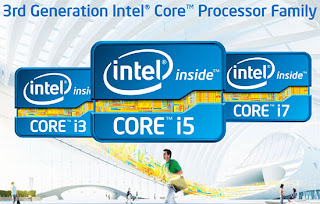Review Ivy Bridge is to explain what it is ivy bridge? and what is its difference with the previous generation processors sandy bridge.
most definitely, ivy bridge is the first generation 22 nanometer processors in the world.
Ivy Bridge, the tick that follows Sandy Bridge, would typically be just that: a mild upgrade that inched performance ahead while dropping power consumption. Intel's microprocessor ticks are usually very conservative on the architecture side, which limits the performance improvement. Being less risky on the architecture allows Intel to focus more on working out the kinks in its next process node, in turn delivering some amount of tangible power reduction.
Where Ivy Bridge shakes things up is on the graphics side. For years Intel has been able to ship substandard graphics in its chipsets based on the principle that only gamers needed real GPUs and Windows ran just fine on integrated graphics. Over the past decade that philosophy required adjustment. First it was HD video decode acceleration, then GPU accelerated user interfaces and, more recently, GPU computing applications. Intel eventually committed to taking GPU performance (and driver quality) seriously, setting out on a path to significantly improve its GPUs.
When Sandy Bridge chips built with 1.16 billion transistors with an area of 216 mm2 die processor, Ivy Bridge chip is built on the 1.4 billion transistor processor with a die area of 160 mm2. 22 nm fabrication process seems to have a big hand in the die shrink the size of the processor even though the number of transistors increases.
Following the lead of Sandy Bridge processors E, Ivy Bridge now has the third-generation PCI Express controller. PCIe 3.0 controller is able to provide a total bandwidth per lane for 8GT / s (1GB / s), while the number of PCIe lanes that can be provided by the Ivy Bridge are as many as 16 pieces.
Intel has many new products lined up for the launch in the next few months, including desktop, mobile and server Ivy Bridge processors, and numerous Xeon Sandy Bridge EP models.
#Desktop
-Core i7 and Core i5. The second fundamental difference lies in the processor serial number of threads and the size of the L3-cache.
-Only the processor with the suffix letter K which has a multiplier unlocked processor.
#Mobile
# Only the QM mobile processor with a letter which is a quad-core processors.
#XM letter indicates that mobile processors have a multiplier unlocked processor.
Review Ivy Bridge









Comments
0 Response to 'Review Ivy Bridge'
Post a Comment